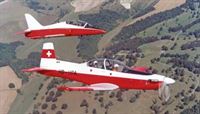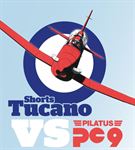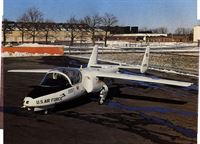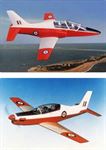Фотографии
-
Регистрационный номер: ZF288 In March 1985 it was announced that the Shorts-built Tucano fitted with the Garrett TPE-331 powerplant was the winner of AST.412, with 130 to be purchased for the RAF. The Tucano T.1 entered RAF service in 1988, providing sterling service in both red-and-white and all-black (adopted in 1996) colour schemes for 30-plus years.
Самолёты на фотографии: Embraer EMB-312 / AT-27 Tucano - Бразилия - 1980
-
Регистрационный номер: ZF510 Shorts Tucano T.1 ZF510 is put through its paces on a low-level training flight.
Самолёты на фотографии: Embraer EMB-312 / AT-27 Tucano - Бразилия - 1980
-
Регистрационный номер: PP-ZDK The third prototype Embraer EMB-312 Tucano, PP-ZDK, made its first flight on August 16, 1982, and flew across the Atlantic a matter of days later to participate in that year’s SBAC show at Farnborough, where it is seen here in its attractive demonstration colour scheme. It was also test-flown by an RAF pilot during the same UK visit.
Самолёты на фотографии: Embraer EMB-312 / AT-27 Tucano - Бразилия - 1980
-
Регистрационный номер: HB-HPA Switzerland’s Pilatus PC-9 was a development of the same company’s PC-7. The first pre-production example (there was no prototype as such, initial testing of the modifications being completed with a PC-7) is seen here alongside a Hawk, the type for which it was competing to be the lead-in aircraft in the RAF’s training syllabus.
Самолёты на фотографии: Hawker-Siddeley Hawk / HS.1182 - Великобритания - 1972Pilatus PC-9 - Швейцария - 1984
-
Самолёты на фотографии: Pilatus PC-9 - Швейцария - 1984
-
From France came the Aerospatiale Epsilon TP, a turboprop-powered variant of its original piston-engined trainer. The prototype Epsilon was fitted with a Turbomeca TP 319 Arrius powerplant, as seen here at the 1987 Paris Air Salon, to be rebranded as the Omega.
Самолёты на фотографии: SOCATA TB-30 Epsilon - Франция - 1979
-
Регистрационный номер: XW318 The Jet Provost T.5 was a pressurised variant of the T.4, modified to reflect the increasing emphasis placed on high-altitude training from the mid-1960s. The first production example joined the RAF in September 1969. Luton-built T.5 XW318 is seen here on a photographic sortie during the SBAC show at Farnborough in 1970.
Самолёты на фотографии: Hunting Percival Jet Provost / P.84 - Великобритания - 1954
-
Регистрационный номер: YR-IGB One of the less likely contenders for AST.412 was the Romanian ICA Brasov IAR-825TP Triumf, the prototype of which is seen here at the 1982 SBAC show at Farnborough. Powered by a PT-6A, only one was built.
Самолёты на фотографии: IAR IAR-825 Triumf / IAR-831 Pelican - Румыния - 1982
-
Регистрационный номер: G-SFTS With the addition of a Pratt & Whitney Canada PT-6A turboprop engine, the NDN Aircraft Ltd NDN-1 Firecracker became the Turbo Firecracker. The first, G-SFTR, first flew in September 1983. Two more were built: G-SFTS, as seen here, and G-SFTT, all of which were acquired by Carlisle-based Specialist Flying Training Ltd.
Самолёты на фотографии: NDN Firecracker / Turbo Firecracker - Великобритания - 1977
-
Spain’s submission to AST.412 was the CASA 101 Aviojet, the prototype of which is seen here at the 1980 SBAC show at Farnborough. Despite having garnered orders in Latin America, it was deemed too expensive and too advanced to be a basic trainer.
Самолёты на фотографии: CASA C-101 Aviojet - Испания - 1977
-
Offering a 65 per cent workshare arrangement with a UK-based manufacturer, West Germany’s Rhein-Flugzeugbau fielded its Fantrainer 400/600, the prototype of which is seen here in June 1982. Of unusual configuration, the Fantrainer incorporated a mid-fuselage-mounted ducted fan.
Самолёты на фотографии: Rhein-Flugzeugbau (RFB) Fantrainer - Германия - 1977
-
The T-46A was rolled-out at Farmingdale on 11 February 1985, and was subsequently ferried to Edwards AFB in a Lockheed Galaxy for its early summer first flight. The second FSD aircraft is to join the programme later this year.
A submission from the USA came in the form of the Fairchild T-46A Eaglet, powered by a pair of Garrett F109-GA-100 turbofans. The fact that it had side-by-side seating and insufficient fuel capacity to achieve even the low-altitude element of AST.412 operations militated against it. The entire T-46A programme was cancelled in 1986.Самолёты на фотографии: Fairchild-Republic T-46 Eaglet - США - 1985
-
By the early 1980s the Brough Division of British Aerospace (BAe) was some way into studies for the RAF’s new-generation trainer, contemporaneous promising designs being the turbofan-powered P.164-08 (also known as NBT108), seen at top, which bore a striking resemblance to the BAe Hawk; and P.164-09 (NBT 109), below, powered by a turboprop engine, which adopted the configuration common to most of its AST.412 rivals.
Самолёты на фотографии: BAe Hawk 100 - Великобритания - 1987
-
Регистрационный номер: I-CAVT Cheapest of the turbofan-powered contenders for AST.412 was Italy’s Caproni Vizzola C22J, developed from the company’s series of sailplanes and powered by a pair of Microturbo TSR 18-1s. Its side-by-side seating, lack of ejection seats and poor climb performance ruled it out.
Самолёты на фотографии: Caproni Vizzola C22J - Италия - 1980
-
A collaboration between the Australian Aircraft Consortium and UK company Westland, the A20 Wamira II was a development of the proposed (and not completed) side-by-side A10 Wamira trainer. The AAC was formed by the three main Australian aircraft manufacturers - CAC, GAF and Hawker de Havilland. Westland had no hand in designing the A20’s tandem-seat fuselage, but was involved in the selection and fitting of avionics for AST.412.
Самолёты на фотографии: AAC A.20 Wamira - Австралия - 1986
Статьи
- -
- A.Griffith - American domination?
- A.Tincopa - Wings over Peru
- B.Cahill - Lightning Bugs & Buffalo Hunters
- D.Buckmaster - Ceres. The goddess from Fishermans Bend
- G.Endres - Baltic Triangles
- J.Jackson - Shorts Tucano vs Pilatus PC9
- K.Hayward - The De Havilland Comet & the British Government. A life in politics? (1)
- L.Andersson - Sweden's secret airbases
- L.Hellstrom - Air Sud Kasai. The National Airline That Never Was
- M.Napier - Taking the war to the enemy
- M.Willis - Tilting at windmills
- P.Davidson - Off the Beaten Track...
- P.Jarrett - Lost & Found
- R.Pegram - Supermarine by submarine
- S.Goncalves - VASP flight 169. Close encounter or celestial illusion?














